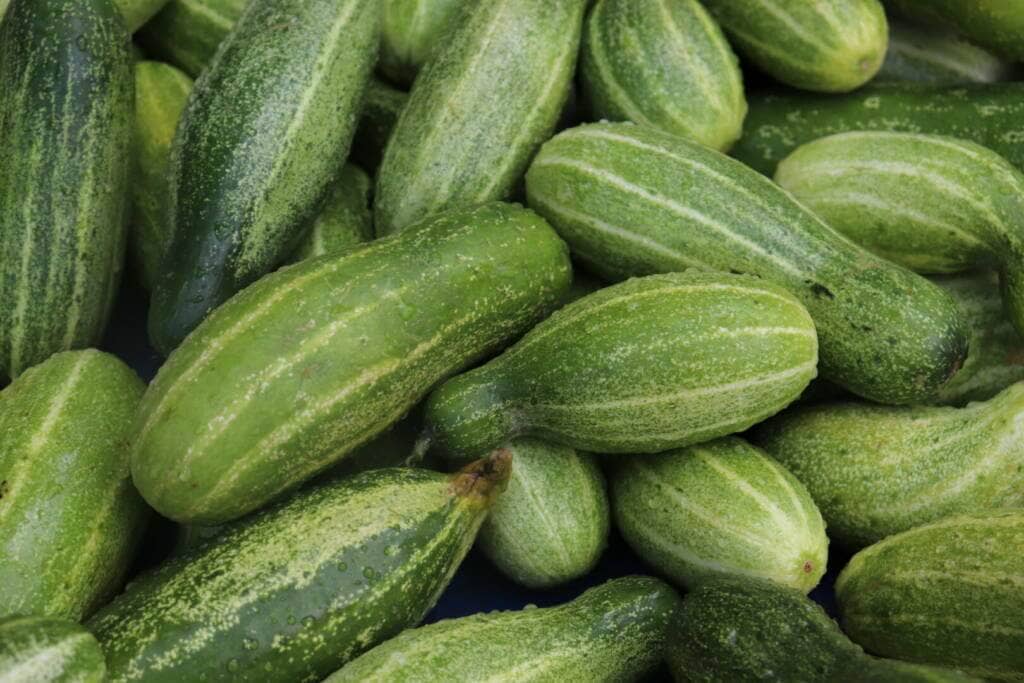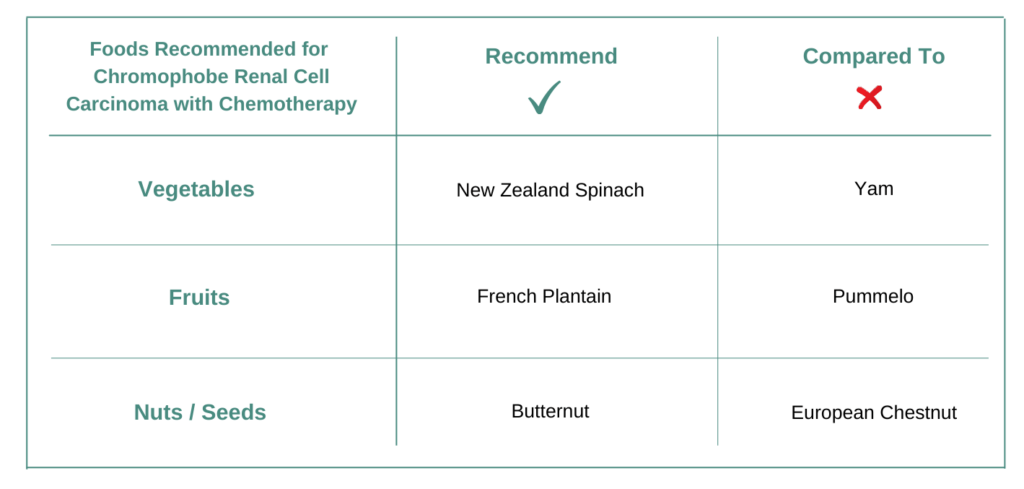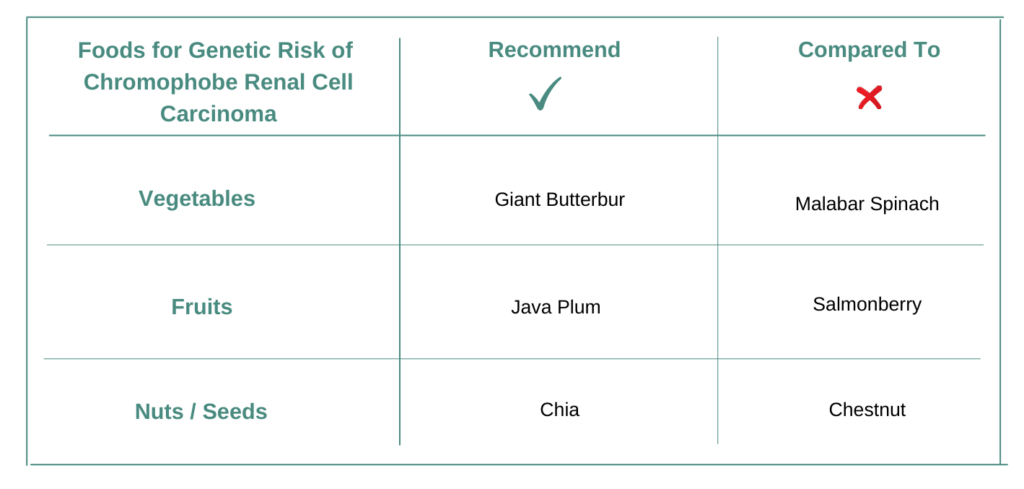Introduction
Foods for Chromophobe Renal Cell Carcinoma should be personalized for each individual and also must adapt when cancer treatment or tumor genetic change. The personalization and adaptation must consider all the active ingredients or bioactives contained in different foods with respect to cancer tissue biology, genetics, treatments, lifestyle conditions and diet preferences. Hence while nutrition is one of the very important decisions for a cancer patient and individual at risk of cancer to make – how to choose foods to eat is not an easy task.
Chromophobe renal cell carcinoma (RCC) is a rare subtype of kidney cancer that arises from the renal tubular epithelial cells. Pathology outlines play a crucial role in understanding the characteristics and features of chromophobe RCC, aiding in accurate diagnosis. Radiology techniques, such as imaging tests, help in visualizing and evaluating chromophobe RCC tumors. Metastasis, or the spread of cancer, is a concern in advanced stages of chromophobe RCC. Treatment options for chromophobe RCC involve a multidisciplinary approach, including surgery, targeted therapy, and immunotherapy, tailored to each individual case. Accurate staging is essential for determining the extent of the cancer. Understanding the genetics and genomic alterations associated with chromophobe RCC is an active area of research. Prognosis and survival rates for chromophobe RCC may vary depending on various factors, including the stage of the cancer and the response to treatment. It is important to recognize the symptoms of chromophobe RCC, which may include blood in urine, abdominal pain, and fatigue. Proper coding using the ICD-10 system ensures accurate documentation of chromophobe RCC in medical records. Continuous research and advancements in treatment options aim to improve outcomes for individuals with chromophobe RCC. Timely diagnosis and prompt intervention help optimize treatment efficacy and improve the quality of life of patients with chromophobe RCC.
For Chromophobe Renal Cell Carcinoma does it matter what vegetables, fruits, nuts, seeds one eats?
A very common nutrition question asked by cancer patients and individuals at-genetic risk of cancer is – for cancers like Chromophobe Renal Cell Carcinoma does it matter what foods I eat and which I do not? Or if I follow a plant-based diet is that enough for cancer like Chromophobe Renal Cell Carcinoma?
For example does it matter if vegetable New Zealand Spinach is consumed more compared to Yam? Does it make any difference if fruit Pummelo is preferred over French Plantain? Also if similar choices are made for nuts/seeds like Butternut over European Chestnut and for pulses like Gram Bean over Catjang Pea. And if what I eat matters – then how does one identify foods which are recommended for Chromophobe Renal Cell Carcinoma and is it the same answer for everyone with the same diagnosis or genetic risk?
Yes! Foods you eat matters for Chromophobe Renal Cell Carcinoma!
Food recommendations may not be the same for everyone and can be different even for the same diagnosis and genetic risk.

All foods (vegetables, fruits, nuts, seeds, pulses, oils etc.) and nutritional supplements are made up of more than one active molecular ingredient or bio-actives in different proportions and quantities. Each active ingredient has a unique mechanism of action – which can be activation or inhibition of different biochemical pathways. Simply stated foods and supplements which are recommended are those which do not cause an increase of molecular drivers of cancer but reduce them. Else those foods should not be recommended. Foods contain multiple active ingredients – hence when evaluating foods and supplements you need to consider the impact of all active ingredients cumulatively rather than individually.
For example Pummelo contains active ingredients Quercetin, Curcumin, Apigenin, Lycopene, Daidzein. And French Plantain contains active ingredients Quercetin, Curcumin, Apigenin, Myricetin, Daidzein and possibly others.
A common mistake made when deciding and choosing foods to eat for Chromophobe Renal Cell Carcinoma – is to evaluate only selected active ingredients contained in foods and ignore the rest. Because different active ingredients contained in foods may have opposing effects on cancer drivers – you cannot cherry pick active ingredients in foods and supplements for making a nutrition decision for Chromophobe Renal Cell Carcinoma.
YES – FOOD CHOICES MATTER FOR CANCER. NUTRITION DECISIONS MUST CONSIDER ALL ACTIVE INGREDIENTS OF FOODS.
Skills Needed for Nutrition Personalization for Chromophobe Renal Cell Carcinoma?
Personalized nutrition for cancers like Chromophobe Renal Cell Carcinoma consists of recommended foods / supplements; not recommended foods / supplements with example recipes which prioritize use of recommended foods. An example of personalized nutrition can be seen at this link.
Deciding which foods are recommended or not is extremely complicated, requiring expertise in Chromophobe Renal Cell Carcinoma biology, food science, genetics, biochemistry along with good understanding of how cancer treatments work and associated vulnerabilities by which the treatments could stop being effective.
MINIMUM KNOWLEDGE EXPERTISE NEEDED FOR NUTRITION PERSONALIZATION FOR CANCER ARE: CANCER BIOLOGY, FOOD SCIENCE, CANCER TREATMENTS AND GENETICS.
Foods to Eat After Cancer Diagnosis!
No two cancers are the same. Go beyond the common nutrition guidelines for everyone and make personalized decisions about food and supplements with confidence.
Characteristics of cancers like Chromophobe Renal Cell Carcinoma
All cancers like Chromophobe Renal Cell Carcinoma can be characterized by a unique set of biochemical pathways – the signature pathways of Chromophobe Renal Cell Carcinoma. Biochemical pathways like RAS-RAF Signaling, mRNA Splicing, PI3K-AKT-MTOR Signaling, Focal Adhesion are part of the signature definition of Chromophobe Renal Cell Carcinoma. Each individual’s cancer genetics can be different and hence their specific cancer signature could be unique.
The treatments which are effective for Chromophobe Renal Cell Carcinoma need to be cognizant of the associated signature biochemical pathways for each cancer patient and individual at genetic risk. Therefore different treatments with different mechanisms of actions are effective for different patients. Similarly and for the same reasons foods and supplements need to be personalized for each individual. Hence some foods and supplements are recommended for Chromophobe Renal Cell Carcinoma when taking cancer treatment Radiation, and some foods and supplements are not recommended.
Sources like cBioPortal and many others provide population representative patient anonymized data from clinical trials for all cancer indications. This data consists of clinical trial study details like sample size / number of patients, age groups, gender, ethnicity, treatments, tumor site and any genetic mutations.
BIRC6, FAT4, LAMA1, TP53 and PIKFYVE are the top ranked reported genes for Chromophobe Renal Cell Carcinoma. BIRC6 is reported in 1.6 % of the representative patients across all clinical trials. And FAT4 is reported in 1.6 %. The combined population patient data cover ages from 17 to 86. 56.7 % of the patient data are identified as men. The Chromophobe Renal Cell Carcinoma biology along with reported genetics together define the population represented signature biochemical pathways for this cancer. If the individual cancer tumor genetics or genes contributing to the risk are also known then that should also be used for nutrition personalization.
NUTRITION CHOICES SHOULD MATCH WITH EACH INDIVIDUAL’S CANCER SIGNATURE.
Food and Supplements for Chromophobe Renal Cell Carcinoma
For Cancer Patients
Cancer patients on treatment or on palliative care need to make decisions on food and supplements – for the needed dietary calories, for managing any treatment side effects and also for improved cancer management. All plant-based foods are not equal and choosing and prioritizing foods which are personalized and customized to ongoing cancer treatment is important and complicated. Here are some examples providing guidelines for making nutrition decisions.
Choose Vegetable NEW ZEALAND SPINACH or YAM?
Vegetable New Zealand Spinach contains many active ingredients or bioactives such as Quercetin, Curcumin, Apigenin, Myricetin, Lycopene. These active ingredients manipulate various biochemical pathways like Extracellular Matrix Remodelling, NFKB Signaling, Epithelial to Mesenchymal Transition and PI3K-AKT-MTOR Signaling and others. New Zealand Spinach is recommended for Chromophobe Renal Cell Carcinoma when ongoing cancer treatment is Radiation. This is because New Zealand Spinach modifies those biochemical pathways which have been scientifically reported to sensitize the effect of Radiation.
Some of the active ingredients or bioactives in vegetable Yam are Curcumin, Apigenin, Myricetin, Daidzein, Luteolin. These active ingredients manipulate various biochemical pathways like Oxidative Stress and others. Yam is not recommended for Chromophobe Renal Cell Carcinoma when ongoing cancer treatment is Radiation because it modifies those biochemical pathways which make the cancer treatment resistant or less responsive.
VEGETABLE NEW ZEALAND SPINACH IS RECOMMENDED OVER YAM FOR Chromophobe Renal Cell Carcinoma AND TREATMENT Radiation.
Choose Fruit FRENCH PLANTAIN or PUMMELO?
Fruit French Plantain contains many active ingredients or bioactives such as Quercetin, Curcumin, Apigenin, Myricetin, Daidzein. These active ingredients manipulate various biochemical pathways like Extracellular Matrix Remodelling, NFKB Signaling, Epithelial to Mesenchymal Transition and PI3K-AKT-MTOR Signaling and others. French Plantain is recommended for Chromophobe Renal Cell Carcinoma when ongoing cancer treatment is Radiation. This is because French Plantain modifies those biochemical pathways which have been scientifically reported to sensitize the effect of Radiation.
Some of the active ingredients or bioactives in fruit Pummelo are Quercetin, Curcumin, Apigenin, Lycopene, Daidzein. These active ingredients manipulate various biochemical pathways like Oxidative Stress and Heat Stress Response and others. Pummelo is not recommended for Chromophobe Renal Cell Carcinoma when ongoing cancer treatment is Radiation because it modifies those biochemical pathways which make the cancer treatment resistant or less responsive.
FRUIT FRENCH PLANTAIN IS RECOMMENDED OVER PUMMELO FOR Chromophobe Renal Cell Carcinoma AND TREATMENT Radiation.
Choose Nut BUTTERNUT or EUROPEAN CHESTNUT?
Butternut contains many active ingredients or bioactives such as Curcumin, Apigenin, Myricetin, Lycopene, Daidzein. These active ingredients manipulate various biochemical pathways like NFKB Signaling, Cell Cycle, Epithelial to Mesenchymal Transition and RAS-RAF Signaling and others. Butternut is recommended for Chromophobe Renal Cell Carcinoma when ongoing cancer treatment is Radiation. This is because Butternut modifies those biochemical pathways which have been scientifically reported to sensitize the effect of Radiation.
Some of the active ingredients or bioactives in European Chestnut are Quercetin, Ellagic Acid, Curcumin, Apigenin, Myricetin. These active ingredients manipulate various biochemical pathways like Oxidative Stress, Stem Cell Signaling and Epithelial to Mesenchymal Transition and others. European Chestnut is not recommended for Chromophobe Renal Cell Carcinoma when ongoing cancer treatment is Radiation because it modifies those biochemical pathways which make the cancer treatment resistant or less responsive.
BUTTERNUT IS RECOMMENDED OVER EUROPEAN CHESTNUT FOR Chromophobe Renal Cell Carcinoma AND TREATMENT Radiation.

For Individuals with Genetic Risk of Cancer
The question asked by individuals who have genetic risk of Chromophobe Renal Cell Carcinoma or familial history is “What Should I Eat Differently from Before?” and how they should choose foods and supplements to manage risks of the disease. Since for cancer risk there is nothing actionable in terms of treatment – decisions of foods and supplements become important and one of the very few actionable things which can be done. All plant-based foods are not equal and based on identified genetics and pathway signature – the choices of food and supplements should be personalized.
Choose Vegetable GIANT BUTTERBUR or MALABAR SPINACH?
Vegetable Giant Butterbur contains many active ingredients or bioactives such as Curcumin, Apigenin, Lycopene, Daidzein, Phloretin. These active ingredients manipulate various biochemical pathways like PI3K-AKT-MTOR Signaling, Cell Cycle Checkpoints, Epithelial to Mesenchymal Transition and DNA Repair and others. Giant Butterbur is recommended for risk of Chromophobe Renal Cell Carcinoma when associated genetic risk is BIRC6. This is because Giant Butterbur increases those biochemical pathways which counteract the signature drivers of it.
Some of the active ingredients or bioactives in vegetable Malabar Spinach are Curcumin, Apigenin, Quercetin, Lycopene, Daidzein. These active ingredients manipulate various biochemical pathways like Small Molecule Transport, Extracellular Matrix Remodelling, DNA Repair and MAPK Signaling and others. Malabar Spinach is not recommended when risk of Chromophobe Renal Cell Carcinoma when associated genetic risk is BIRC6 because it increases the signature pathways of it.
VEGETABLE GIANT BUTTERBUR IS RECOMMENDED OVER MALABAR SPINACH FOR BIRC6 GENETIC RISK OF CANCER.
Choose Fruit JAVA PLUM or SALMONBERRY?
Fruit Java Plum contains many active ingredients or bioactives such as Curcumin, Apigenin, Ellagic Acid, Lycopene, Daidzein. These active ingredients manipulate various biochemical pathways like PI3K-AKT-MTOR Signaling, Epithelial to Mesenchymal Transition, DNA Repair and P53 Signaling and others. Java Plum is recommended for risk of Chromophobe Renal Cell Carcinoma when associated genetic risk is BIRC6. This is because Java Plum increases those biochemical pathways which counteract the signature drivers of it.
Some of the active ingredients or bioactives in fruit Salmonberry are Curcumin, Apigenin, Daidzein, Phloretin, Beta-sitosterol. These active ingredients manipulate various biochemical pathways like Small Molecule Transport, Cell Cycle Checkpoints and Epithelial to Mesenchymal Transition and others. Salmonberry is not recommended when risk of Chromophobe Renal Cell Carcinoma when associated genetic risk is BIRC6 because it increases the signature pathways of it.
FRUIT JAVA PLUM IS RECOMMENDED OVER SALMONBERRY FOR BIRC6 GENETIC RISK OF CANCER.
Choose Nut CHIA or CHESTNUT?
Chia contains many active ingredients or bioactives such as Curcumin, Apigenin, Lycopene, Daidzein, Phloretin. These active ingredients manipulate various biochemical pathways like PI3K-AKT-MTOR Signaling, Epithelial to Mesenchymal Transition, DNA Repair and P53 Signaling and others. Chia is recommended for risk of Chromophobe Renal Cell Carcinoma when associated genetic risk is BIRC6. This is because Chia increases those biochemical pathways which counteract the signature drivers of it.
Some of the active ingredients or bioactives in Chestnut are Curcumin, Apigenin, Ellagic Acid, Lycopene, Daidzein. These active ingredients manipulate various biochemical pathways like Epithelial to Mesenchymal Transition and DNA Repair and others. Chestnut is not recommended when risk of Chromophobe Renal Cell Carcinoma when associated genetic risk is BIRC6 because it increases the signature pathways of it.
CHIA IS RECOMMENDED OVER CHESTNUT FOR BIRC6 GENETIC RISK OF CANCER.

In Conclusion
Foods and Supplements chosen are important decisions for cancers like Chromophobe Renal Cell Carcinoma. Chromophobe Renal Cell Carcinoma patients and individuals with genetic-risk always have this question: “What foods and nutritional supplements are recommended for me and which are not?” There is a common belief which is a misconception that all plant-based foods could be beneficial or not but would not be harmful. Certain foods and supplements can interfere with cancer treatments or promote molecular pathway drivers of cancer.
There are different types of cancer indications like Chromophobe Renal Cell Carcinoma, each with different tumor genetics with further genomic variations across each individual. Further every cancer treatment and chemotherapy has a unique mechanism of action. Each food like New Zealand Spinach contains various bioactives in different quantities, which have an impact on different and distinct sets of biochemical pathways. The definition of personalized nutrition is individualized food recommendations for the cancer indication, treatments, genetics, lifestyle and other factors. Nutrition personalization decisions for cancer require knowledge of cancer biology, food science and an understanding of different chemotherapy treatments. Finally when there are treatment changes or new genomics is identified – the nutrition personalization needs re-evaluation.
The addon nutrition personalization solution makes the decision making easy and removes all the guesswork in answering the question, “What foods should I choose or not choose for Chromophobe Renal Cell Carcinoma?”. The addon multi-disciplinary team includes cancer physicians, clinical scientists, software engineers and data scientists.
Personalized Nutrition for Cancer!
Cancer changes with time. Customize and modify your nutrition based on cancer indication, treatments, lifestyle, food preferences, allergies and other factors.
References
- Pan Origimed 2020
- Cell-of-Origin Patterns Dominate the Molecular Classification of 10,000 Tumors from 33 Types of Cancer.
- Scalable Open Science Approach for Mutation Calling of Tumor Exomes Using Multiple Genomic Pipelines.
- Genomic and Functional Approaches to Understanding Cancer Aneuploidy.
- Driver Fusions and Their Implications in the Development and Treatment of Human Cancers.
- An Integrated TCGA Pan-Cancer Clinical Data Resource to Drive High-Quality Survival Outcome Analytics.
- Oncogenic Signaling Pathways in The Cancer Genome Atlas.
- Microbiome analyses of blood and tissues suggest cancer diagnostic approach.
- Perspective on Oncogenic Processes at the End of the Beginning of Cancer Genomics.
- Landscape of Microsatellite Instability Across 39 Cancer Types.
- β-Sitosterol and Gemcitabine Exhibit Synergistic Anti-pancreatic Cancer Activity by Modulating Apoptosis and Inhibiting Epithelial-Mesenchymal Transition by Deactivating Akt/GSK-3β Signaling.
- Betulinic Acid Suppresses Breast Cancer Metastasis by Targeting GRP78-Mediated Glycolysis and ER Stress Apoptotic Pathway.
- Gallic acid provokes DNA damage and suppresses DNA repair gene expression in human prostate cancer PC-3 cells.
